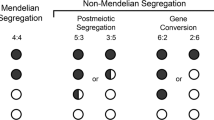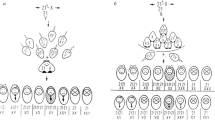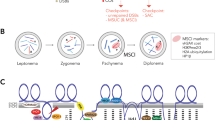Abstract
THE t complex of the mouse consists of a large series of genetic factors often characterised by embryonic lethality of the homozygotes, reduced male fertility of viable homozygotes, suppression of recombination over a relatively long chromosomal segment and relatively frequent occurrence in natural mouse populations. Most t factors also possess a component which interacts with the Brachyury (T) gene and causes complete absence of the tail in T/t heterozygotes. One of the most fascinating but least explored characteristics of the t factors is their effect on genetic segregation. A male mouse carrying a t factor in a heterozygous condition (t/−) often transmits the factor to almost 100% of its progeny, in defiance of the Mendelian principle requiring 1:1 segregation.
This is a preview of subscription content, access via your institution
Access options
Subscribe to this journal
Receive 51 print issues and online access
$199.00 per year
only $3.90 per issue
Buy this article
- Purchase on Springer Link
- Instant access to full article PDF
Prices may be subject to local taxes which are calculated during checkout
Similar content being viewed by others
References
Sandier, L., and Novitski, E., Am. Nat., 41, 105–110 (1957).
Klein, J., Proc. natn. Acad. Sci. U.S.A., 68, 1594–1597 (1971).
Ford, C. E., and Hamerton, J. L., Stain Technol., 31, 247–251 (1956).
Meredith, R., Chromosoma, 26, 254–258 (1969).
Braden, A. W. H., Nature, 181, 786–787 (1958).
Yanagisawa, K., Dunn, L. C., and Bennett, D., Genetics, 46, 1635–1644 (1961).
Erickson, R. P., Nature new Biol., 243, 210–212 (1973).
Yanagisawa, K., Pollard, D. R., Bennett, D., Dunn, L. C., and Boyse, E. A., Immunogenetics, 1, 91–96 (1974).
Author information
Authors and Affiliations
Rights and permissions
About this article
Cite this article
HAMMERBERG, C., KLEIN, J. Evidence for postmeiotic effect of t factors causing segregation distortion in mouse. Nature 253, 137–138 (1975). https://doi.org/10.1038/253137a0
Received:
Revised:
Issue Date:
DOI: https://doi.org/10.1038/253137a0
This article is cited by
-
A meiotic driver alters sperm form and function in house mice: a possible example of spite
Chromosome Research (2022)
-
An investigation of transmission ratio distortion in the central region of the human MHC
Genes & Immunity (2006)
-
Distortion of transmission ratio by a candidate t complex responder locus transgene
Mammalian Genome (1992)
-
Transmission distortion of t-haplotypes is due to interactions between meiotic partners
Nature (1985)
Comments
By submitting a comment you agree to abide by our Terms and Community Guidelines. If you find something abusive or that does not comply with our terms or guidelines please flag it as inappropriate.



